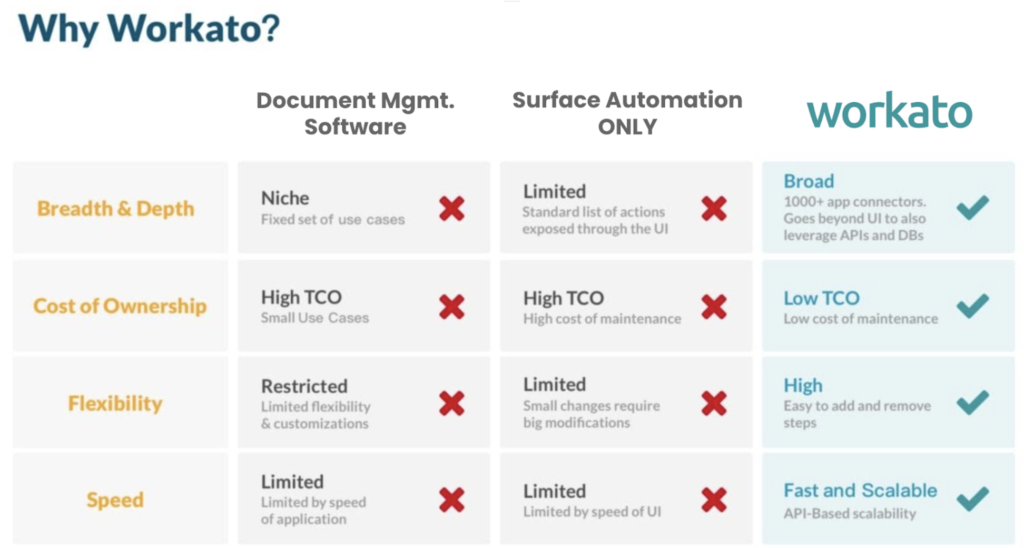There are a million ways to streamline your workflows, but robotic process automation (RPA) is perhaps the most misunderstood. According to the Institute for Robotic Process Automation and Artificial Intelligence, RPA is an application of technology that aims to automate repetitive business processes. RPA tools allow a company to configure software—a “robot,” so to speak—in order to capture and interpret applications for processing transactions, manipulating data, triggering responses, and communicating with other digital systems.
But where does RPA fit in the greater scheme of intelligent automation? And how can you best leverage it to create seamless, automated workflows?
Why Is RPA Useful?
Unlike other forms of automation, which engage with systems on the back end, RPA interacts with systems on the user interface (UI) level. It mimics the actions a human would take when interacting with that app or database, such as clicking on buttons, selecting an option from a drop-down menu, or keying in data. In this way, RPA can automate repetitive tasks that previously required human input—like queries, calculations, and record or transaction maintenance.
Related: iPaaS vs RPA
Applications of RPA: Surface Automation and Document Processing
RPA can be a valuable tool for users who need to integrate with legacy on-prem systems. Many older mainframe systems, for example, can’t easily be accessed via API. If you want to automate the process of adding data to or manipulating data within one of those systems, you can only do so through surface automation. RPA provides a workable solution for accessing and working with data housed in those systems.
Some businesses also use RPA for document processing. RPA tools can open a PDF file, for example, parse the contents, and move the file from one place to another. But this application of RPA has distinct drawbacks. The most obvious problem is that because RPA engages with systems on a surface level, processes built with RPA are notoriously brittle. If a document’s format changes, for example, the RPA process must change as well. This can be a real challenge when trying to streamline your workflows.
Dealing with Brittle Workflows: The Pros and Cons of RPA
A more general issue with RPA is that performance is gated by the application UX, so the process’s speed is limited to the speed of the application. Ultimately, surface automations and document processing are only a small part of the bigger automation requirements of businesses today. RPA tools often have a high total cost of ownership (TCO), but they are useful for only a small handful of workflows.
Related: The advantages of RPA—and why you still need an enterprise automation platform
How to Integrate with RPA Tools and Use A.I. and ML in Your Workflows
If you truly need to use surface automation in a workflow—to automatically key data into a mainframe system, for example—Workato offers an easy but powerful solution. You can enjoy all the benefits of surface automation and Workato’s wide range of features—including the platform’s ability to incorporate cognitive automations and AI.
When it comes to document processing, Surface Automation is not your only option. Workato is more agile and more scalable so it can evolve as your business needs change. To begin with, your workflows are simply less brittle.
Related: How to choose between RPA and API integration
How a Global Food and Nutrition Company Streamlines Order Fulfillment and Shipping with Workato’s API-led Automation andRPA
A global food and nutrition company that ships more than 650 by-products to food manufacturers, pharmaceutical companies, and cosmetics brands in over 100 countries wanted to streamline its order fulfillment and shipping processes. Every order has several documents that must be packed with it when it ships. These include documents like the order invoice and shipping label. If even one item is missing or incorrect, the box cannot be shipped. Additionally, document data must be entered into the company’s mainframe system, which isn’t accessible via API. It’s a time-sensitive and, without automation, a labor-intensive process.
Rather than purchasing a narrowly-tailored RPA tool with only Surface Automation to solve this problem, the company chose to use Workato’s approach with API-led Automation and RPA. When documents are uploaded to the company’s enterprise cloud storage app—such as OneDrive, Box, or Dropbox —Workato picks them up and first determines whether each document is an invoice, a shipping label, or something else.
Workato then associates the correct invoice with the other documents for that order. Once the documents are bundled correctly, Workato sends the bundles to the printer so they can be shipped with the right boxes. Throughout the process, employees can track the status of a particular document. The document data still needs to be entered into the mainframe system, which Workato does via surface automation.
In this case, the workflow saves the company roughly four hours of labor every day and processes about 30,000 pages of documents per month. Not only can the company design a streamlined shipment workflow, but they can use the Workato platform to create a wide range of automations for every business process imaginable. Another benefit is that the company can choose which best-of-breed apps it wants to use for document parsing and storage—and change those apps as their business needs evolve. They can change their cloud storage app, for example, without requiring a developer’s help to tweak the workflow.
Ultimately, businesses today need much more than only Surface Automation. They need pervasive, agile automations that can grow with the business and have a low TCO. Workato offers the best of both worlds, merging API-led Automation with RPA to create flexible workflows.

